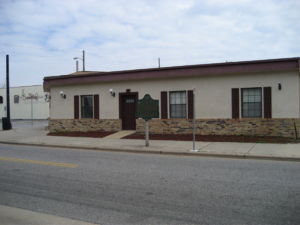Difference between revisions of "Pensacola Opera House"
(New page: {{Infobox Building |image=OldOperaHouseSite.jpg |caption=Historical sign marks the site of the old opera house |name=Pensacola Opera House |location=Jefferson Street at [[Government St...) |
m |
||
| Line 19: | Line 19: | ||
}} | }} | ||
| − | The [[Pensacola Opera House]] was a 1,400-seat theater at the intersection of [[Jefferson Street|Jefferson]] and [[Government Street]]s, across from [[Plaza Ferdinand VII]]. It opened in [[1883]]. According to an 1885 city directory, "the stage which is 50 x 60 feet has 15 sets of scenery, foot-lights and four boxes."<ref>[http://www.rootsweb.com/~flescamb/1885appendix.htm 1885 Pensacola City Directory Appendix</ref> The building was destroyed in a [[1916]] [[hurricane]]. Salvaged bricks and balcony railings were used in the construction of the [[Saenger Theatre]]. | + | The [[Pensacola Opera House]] was a 1,400-seat theater at the intersection of [[Jefferson Street|Jefferson]] and [[Government Street]]s, across from [[Plaza Ferdinand VII]]. It opened in [[1883]]. According to an 1885 city directory, "the stage which is 50 x 60 feet has 15 sets of scenery, foot-lights and four boxes."<ref>[http://www.rootsweb.com/~flescamb/1885appendix.htm 1885 Pensacola City Directory Appendix]</ref> The building was destroyed in a [[1916]] [[hurricane]]. Salvaged bricks and balcony railings were used in the construction of the [[Saenger Theatre]]. |
==Pensacola Advertising Company== | ==Pensacola Advertising Company== | ||
| − | In [[1902]] manager [[John M. Coe]] created the "Pensacola Advertising Company," a small poster business to promote the opera house. He took a business partner, [[Charles W. Lamar, Sr.]], in [[1905]]. When the two men dissolved their business relationship in [[1908]], the poster company went to Lamar and was renamed [[Lamar Advertising]]. According to Lamar company lore, "a coin toss was used to divide their assets," and Lamar "lost."<ref>[http://www.lamar.com/main/about/History.cfm Lamar Company History</ref> Of course, the opera house was destroyed eight years later, while Lamar Advertising went on to become a billion-dollar multinational. | + | In [[1902]] manager [[John M. Coe]] created the "Pensacola Advertising Company," a small poster business to promote the opera house. He took a business partner, [[Charles W. Lamar, Sr.]], in [[1905]]. When the two men dissolved their business relationship in [[1908]], the poster company went to Lamar and was renamed [[Lamar Advertising]]. According to Lamar company lore, "a coin toss was used to divide their assets," and Lamar "lost."<ref>[http://www.lamar.com/main/about/History.cfm Lamar Company History]</ref> Of course, the opera house was destroyed eight years later, while Lamar Advertising went on to become a billion-dollar multinational. |
==References== | ==References== | ||
Revision as of 17:55, 16 March 2007
| Pensacola Opera House | |
 Historical sign marks the site of the old opera house | |
| Building Information | |
|---|---|
| Location | Jefferson Street at Government |
| Client | John M. Coe |
| Engineer | Daniel F. Sullivan (?) |
| Completion Date | 1883 |
| Date Demolished | 1916 (hurricane) |
| Size | 1,400 seats |
The Pensacola Opera House was a 1,400-seat theater at the intersection of Jefferson and Government Streets, across from Plaza Ferdinand VII. It opened in 1883. According to an 1885 city directory, "the stage which is 50 x 60 feet has 15 sets of scenery, foot-lights and four boxes."[1] The building was destroyed in a 1916 hurricane. Salvaged bricks and balcony railings were used in the construction of the Saenger Theatre.
Pensacola Advertising Company
In 1902 manager John M. Coe created the "Pensacola Advertising Company," a small poster business to promote the opera house. He took a business partner, Charles W. Lamar, Sr., in 1905. When the two men dissolved their business relationship in 1908, the poster company went to Lamar and was renamed Lamar Advertising. According to Lamar company lore, "a coin toss was used to divide their assets," and Lamar "lost."[2] Of course, the opera house was destroyed eight years later, while Lamar Advertising went on to become a billion-dollar multinational.